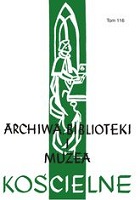STAN BIBLIOTEK I ZBIORÓW ARCHIWALNYCH BAZYLIAŃSKICH KLASZTORÓW W ŚWIETLE WIZYTACJI (1799-1824)
THE CONDITION OF LIBRARIES AND ARCHIVAL COLLECTIONS OF BASILIAN MONASTERIES IN THE LIGHT OF THE VISITATION (1799-1824)
Author(s): Irena WodzianowskaSubject(s): Christian Theology and Religion, History of Church(es), Library and Information Science, Archiving, 18th Century, 19th Century
Published by: Katolicki Uniwersytet Lubelski Jana Pawła II - Wydział Teologii
Keywords: libraries; visitation files; monastic archives; Basilian fathers; the Uniate Diocese of Lutsk; Greek Catholic Church;
Summary/Abstract: The basic sources in the research on monastic libraries, apart from library catalogues, include visitation files, recording the numerical size of communities and the size of monastic book collections. The visiting inspectors recorded the number of volumes, contents, library rooms and the archival documentation of individual monastic institutions. The preserved visitations to Basilian monasteries allow for the analysis of 27 book collections in the Uniate Diocese of Lutsk during the first quarter of the 19th century. This documentation makes it possible to determine the number of collections, the pace of their increase, and their thematic scope. Several years later, after the dissolution of the Basilian Fathers, most of these libraries would be dispersed, a large part of the books donated to educational institutions, while more valuable items were transferred to museums and university libraries. Visitation files are therefore a valuable source for exploring the collections, the places where they were stored, as well as the contents of the monastic archives. Monastic libraries varied in size, organization, and substantive content. They served primarily as support in the pastoral and educational work of monks. Both theological works and fiction works, as well as Western European manuscripts and editions were collected in the monasteries. The range of Polish and foreign typographies testified to the high intellectual culture of the order. Even small communities scattered in rural centres offered the opportunity of contact with books and educating local youth. Undoubtedly, they formed the cultural landscape of these lands.
Journal: Archiwa, Biblioteki i Muzea Kościelne
- Issue Year: 2021
- Issue No: 116
- Page Range: 457-482
- Page Count: 26
- Language: Polish

